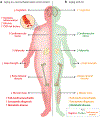Calorie Restriction and Aging in Humans
- PMID: 32559388
- PMCID: PMC9042193
- DOI: 10.1146/annurev-nutr-122319-034601
Calorie Restriction and Aging in Humans
Abstract
Calorie restriction (CR), the reduction of dietary intake below energy requirements while maintaining optimal nutrition, is the only known nutritional intervention with the potential to attenuate aging. Evidence from observational, preclinical, and clinical trials suggests the ability to increase life span by 1-5 years with an improvement in health span and quality of life. CR moderates intrinsic processes of aging through cellular and metabolic adaptations and reducing risk for the development of many cardiometabolic diseases. Yet, implementation of CR may require unique considerations for the elderly and other specific populations. The objectives of this review are to summarize the evidence for CR to modify primary and secondary aging; present caveats for implementation in special populations; describe newer, alternative approaches that have comparative effectiveness and fewer deleterious effects; and provide thoughts on the future of this important field of study.
Keywords: CALERIE; aging; calorie restriction; intermittent fasting; metabolic adaptation.
Figures



References
-
- Arai Y, Sasaki T, Hirose N. 2017. Demographic, phenotypic, and genetic characteristics of centenarians in Okinawa and Honshu, Japan. Part 2. Honshu, Japan. Mech. Ageing Dev 165:80–85 - PubMed
MeSH terms
Grants and funding
LinkOut - more resources
Full Text Sources
Other Literature Sources
Medical

